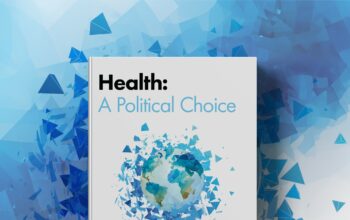5 Questions to …. five leading biopharmaceutical company CEOs and top executives on the COVID-19 Pandemic
This was originally published in Pharma Boardroom on Wednesday, 1 April, 2020.
The CEOs and top executives, David Ricks, Chairman and Chief Executive Officer, Eli Lilly & Co and IFPMA President, Severin Schwan, Chief Executive Officer, Roche, Paul Stoffels, Chief Scientific Officer, Johnson & Johnson, David Loew, Executive Vice-President, Sanofi Pasteur and Rajeev Venkayya, President, Global Vaccines Business Unit, Takeda took part in a virtual press briefing with international journalists hosted by the International Federation of Pharmaceutical Manufacturers & Associations (IFPMA) in Geneva, 19 March 2020.
Thomas Cueni, Director-General, IFPMA set the scene: We are dealing with a truly global public health threat. We see an unprecedented rapid response from both governments (see IFPMA backgrounder here) and the pharmaceutical industry (see its ground-breaking commitments here). Society needs to know it can count on the biopharmaceutical industry to work to rapidly bring forward therapies, vaccines and diagnostics that protect humankind from this escalating pandemic and prepare the industry to better respond to future global health crises.”
Questions posed by Claire Doole, ex-BBC journalist/presenter.
How long do you think it’s going to take to get a vaccine and get it to people in need?
David Loew, Executive Vice-President, Sanofi Pasteur: There is an unprecedented level of collaboration taking place across the industry as it joins hands with public agencies to accelerate new tests, vaccines and therapies. The industry’s commitment is to share tools and insights to test potential therapies and vaccines. We have to be realistic about the months that will be needed to make an approved vaccine available at the kind of scale that will be needed. Right now it is hard to envisage that it will take less than 12 to 18 months to have a vaccine properly tested, approved and available at a large scale, and it could take more than that. The good news is that there is already a vaccine candidate in Phase I clinical trial and there are multiple other candidates following shortly behind. When developing a vaccine, we try to go very fast, working with regulatory authorities to compress the timeline so, instead of waiting two months, you can now get a meeting extremely quickly from FDA or EMA. But what we will not do is sacrifice the determination to be effective and safe. Vaccines must be safe: they are typically injected in healthy people so we must ensure safety.
How can diagnostic tests be increased and speeded up?
Severin Schwan, Chief Executive Officer, Roche: More companies recently got approval for diagnostic testing. So, they will now be going into fabricating millions of tests available on a monthly basis. We have seen big progress in collaboration with other companies, with external partners including the WHO and authorities, regulators particularly. The cooperation with authorities is flawless, around the world companies are receiving the necessary approvals in record time. The industry has been ramping up production, but despite that more testing capacities are provided, demand still by far outstrips supply. So, it is vital that testing is really targeted for high-risk patients and patients who show signs and symptoms of the disease. Broad-based testing at this stage is simply not feasible as far as the tempo of increasing capacities is concerned.
How does the industry work on access to and affordability of a COVID-19 solution?
David Ricks, Chairman and Chief Executive Officer, Eli Lilly & Co, IFPMA President: This is the moment this industry will rise to the occasion and marshal every bit of scientific knowledge and know-how we have to solve a humanitarian problem. Individual pricing decisions will be up to the inventors and the manufacturers and there are solutions, but the spirit across the industry is one of speedy collaboration and applying our scientific expertise to solve the problem. We are committed today to play our part and do it in a robust way to bring the full force of our scientific expertise to this problem. I have never seen the kind of collaboration not only across industry partners but also with biotech, academia and governments that I’m seeing today and the timeline by which we’re moving is truly remarkable.
How can we flatten the curve given that this virus is progressing so fast and where should we focus our efforts?
Rajeev Venkayya, President, Global Vaccines Business Unit, Takeda: The flattening the curve strategy is critical: early, coordinated interventions to dampen transmission of the virus in the community. This has been taken up around the world in this pandemic to varying degrees, but due to late and inconsistent implementation it has not been enough. At this point my greatest concern is the “healthcare surge” – the need for hospital beds and healthcare workers who are appropriately protected, healthy and able to stay in the workforce. They are at high risk of significant exposure to the virus and potentially outcomes that you wouldn’t expect in individuals without risk factors. We must to do everything we can to protect them. In the immediate term this means the provision of adequate personal protective equipment to all healthcare personnel, and in the longer term medicines and vaccines to prevent and treat COVID-19 illness.
What are the industrial challenges? Is there a problem with business continuity?
Paul Stoffels, Chief Scientific Officer, Johnson & Johnson: We are committed to increasing manufacturing capabilities and sharing available capacity to ramp up production once a successful vaccine or treatment is developed and working to secure continuity of supply for all essential medicines, vaccines and diagnostics for patients with other life-threatening diseases. The scale of what is required is unprecedented and industry will have to work together with all the different partners to ensure that enough capacity is available if a vaccine is there – and that everyone can get vaccinated to be protected.
It’s not just one pharmaceutical industry who will do this, it’s a combination of many working together with the best possible efforts, in research but also in the supply chain: sharing capability and sharing manufacturing capacity in order to get there. That is normal for us to do at this moment in time for solving COVID-19.
Don’t forget there are still people having cancer, having inflammation, having all different needs; we need to continue to provide all the essential medicines and we should be considered as essential workers in healthcare.
Thomas Cueni, Director-General, IFPMA concludes: I have never seen this industry as united in fighting a public health threat as on coronavirus. The reasons are that we are all in this together. We won’t rest until we find the solution to lift the burden of this virus on our families, friends, patients, on our societies and the economy.
Further reading: IFPMA news release, 19 March 2020





